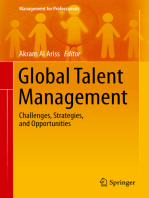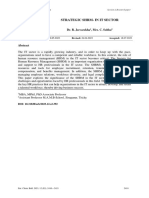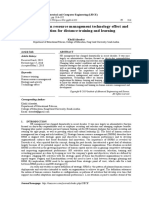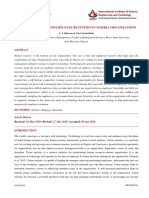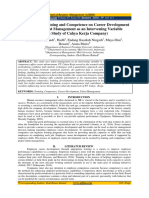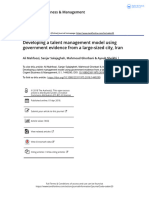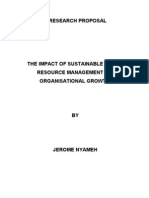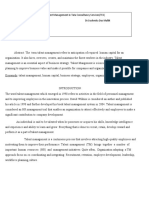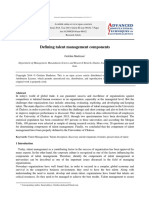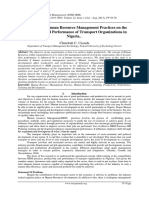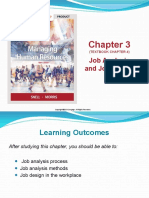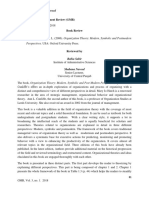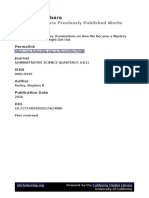Professional Documents
Culture Documents
The South African Police Service in South Africa Fails To Nurture Talent Development
Original Title
Copyright
Available Formats
Share this document
Did you find this document useful?
Is this content inappropriate?
Report this DocumentCopyright:
Available Formats
The South African Police Service in South Africa Fails To Nurture Talent Development
Copyright:
Available Formats
Volume 8, Issue 1, January – 2023 International Journal of Innovative Science and Research Technology
ISSN No:-2456-2165
The South African Police Service in South Africa
Fails to Nurture Talent Development
Dr. John Motsamai Modise Dr. Kishore Raga
South African Police Service Professor Emeritus: Nelson Mandela University
Abstract:- The article investigates the problems faced by I. INTRODUCTION AND BACKGROUND
the South African Police Service regarding the acute
shortage and development of talent and why talent Organisations recognise that talent management (TM)
management has been not been introduced in the Police is important in ensuring a competitive advantage (Collings
Department. It examines the importance and benefits of and Mellahi, 2009; Fegley, 2006a; Gallardo-Gallardo, Dries
developing talent management programmes at the Police and González-Cruz, 2013; Goetsch, 2010; Khoreva, Vaiman
Department and demonstrates why the police needs and Van Zalk, 2017; McDonnell, Collings, Mellahi and
talent management to develop future leaders. It also Schuler, 2017; Vaiman, Scullion and Collings, 2012),
seeks to find out whether the Police are ready to however, they lament their TM efforts fail (Ashton and
implement a TM programme. The importance of Morton, 2005; Beechler and Woodward, 2009; Bersin,
developing talent management programmes in the police Houston and Kester, 2014; Collings, 2014, 2015). Several
service to develop and build a talent pool as a key human reasons are advanced for the ineffective TM efforts, ranging
resource. Secondly, discuss factor(s) that cause(s) the from skills shortages and the ‘war for talent’ (Frank,
poor implementation of talent management practices Finnegan and Taylor, 2004; Ewerlin, 2013; Hejase, Hejase,
within the police. Lastly, examine how the employees Mikdashi and Bazeih, 2016; Nilsson and Ellström, 2012;
perceive the influence of better talent management Vaiman et al. 2012). Talent management is a strategic,
practices in the police. It assesses the relevance of talent integrated approach to managing the career of an employee,
management and makes recommendations on how to from the moment of attraction to the institution
develop an integrated talent management programme, to (recruitment), through selecting the suitable candidate for a
achieve the mission objectives of the government. It position, employing the various phases of developing an
seeks to find out the challenges and obstacles that hinder employee, through the continuous motivation of an
the development of talent management within the South employee towards performance and actions to retain the
African Police Service Department in South Africa. The employee (Vermeulen, 2008:40).
following factors are also discussed. This research article
will contribute to the literature on talent management Davies and Davies (2010:419) underscore
practice and its influence on the sustainability of Vermeulen’s definition that talent management is the
organisational routine in the South African Police systematic attraction, identification, development,
Service in South Africa. This article offers a holistic engagement, retention and deployment of employees to the
approach to using and managing human potential most best of their abilities and capacities. Therefore, talent
efficiently and practically through talent management, management is a continuous process throughout an
notwithstanding the numerous problems and employee’s career; integrated with various Human Resource
institutional resource constraints. The findings of the Management (HRM) practices. In this study, the focus is on
article have practical implications as they help raise managing talented tutors/trainers (hereafter referred to as
awareness amongst the decision makers within the police academics) in the South African Police Service (hereafter
service of the need for developing talent management referred to as SAPS), with significant potential and of
capabilities. They will also make a valuable contribution particular value to the institution.
to knowledge through reviewing and expanding the
literature on talent management programmes, and II. THEORETICAL FRAMEWORK:
provide an opportunity for researchers to undertake INTEGRATED TALENT MANAGEMENT
further studies which could be useful for different FRAMEWORK
organisations wishing to develop talent management
programmes. The integrated Talent Management conceptual
framework, according to Amala and Aarulandu (2021),
Keywords:- Talent management, Police officials, Training displays the framework and resources required to recruit,
and development, Employees Turnover, Talent management use, develop and retain the top talent in each profession.
strategies, Talent Management programmes. This will aid organisations in making workforce-wide,
smarter, quicker, data-driven decisions. HR and the manager
collaborate throughout the talent management continuum to
manage the employee experience from hire to retirement or
transition. The researcher's model, which was built on the
IJISRT23JAN219 www.ijisrt.com 1902
Volume 8, Issue 1, January – 2023 International Journal of Innovative Science and Research Technology
ISSN No:-2456-2165
talent management aspects with additional chosen factors, can be adapted for use in public sector organisations (Kumar
&Rajasekar,2013).
Fig 1 Integrated Talent Management Framework
Retrieved from: https:// www.valamis.com/hub/talent-management#talent-management
The Integrated Talent Management model will be discussed competencies which will help with its future business needs
below: (Hongal & Kinange, 2020). Many organisations
Talent Strategy And Planning: discriminate between the benefits of utilizing modern talent
In its broadest sense, talent planning is a set of people acquisition technology and the chance to rationalize the
management tactics used by businesses to recruit and keep entire recruitment process (Hongal & Kinange, 2020). The
outstanding talent (Thunnissen & Buttiens, 2017). These development of employee value applications and manager
procedures, which aim to develop and preserve a high- adjustments are increasingly prioritized in these talent
performing workforce, are regularly modified to meet the management methods to retain and cultivate the best
demands and overarching goals of the particular personnel for the positions (Martin & Sinclair, 2019).
organisation. However, creating risk-reduction strategies
and company plans requires planning. This process will Talent Performance Management:
assist the employer to have the right people in the right roles When implementing strategic goals, talent
to satisfy the expectations of the organisation; for this to management and performance management are used as
play out the organisation must, of course, have a talent tactical methods to enhance employee and organisational
planning strategy in place (Thunnissen & Buttiens, 2017). performance (Masri and Suliman, 2019). Organisations are
Given how frequently organisational requirements change, it urged to develop a talent culture that will allow staff
is essential to keep the personnel planning strategy closely members to support strategic goals and maintain talent
aligned with the current business objectives (Thunnisen & performance stability (Masale, 2020): in essence, clear roles,
Gallardo Gallardo, 2004). opportunities to utilize talents and participation in career
decisions are all necessary for talented employees to flourish
Talent Acquisition: professionally (Lesenyeho, 2017). Furthermore,
The process of hiring talent has been well-defined as compensation, work-life balance, leadership and
talent acquisition (Stahl et al., 2012), and using a long-term management support, performance management and growth
strategy for hiring that is in line with the organisational and occupational health and safety are all important
objective (Hongal & Kinange, 2020) is important for each elements of talent management in the public sector (Alves et
institution. This process assists with identifying, attracting, al., 2020).
engaging, and retaining highly qualified personnel and
provides the foundation for the organisation's current
IJISRT23JAN219 www.ijisrt.com 1903
Volume 8, Issue 1, January – 2023 International Journal of Innovative Science and Research Technology
ISSN No:-2456-2165
Talent Development: might involve retraining and upskilling personnel in addition
The strategic direction of the organisation must be to other focused programs to get them ready for career
connected to talent development, which is a crucial growth. Talent development refers to efforts to find, nurture,
component of the talent management process (Lesenyeho, and elevate employees inside an organisation. Talent is
2017). It is believed that the employee will be happier and recognized as a crucial component of both local and global
more fulfilled when the talent development goals, including talent management (Alferaih et al., 2018). Organisations
transparent information, leadership development transform the talent they already have into the leaders they
programmes, mentorship and succession planning, benefit will need in the future through leadership development
the demands of both workers and organisations (Bidwell, (Dalayga and Baskaran, 2019). To encourage the growth of
2018). Given the rapidly changing environment, developing outstanding performances in certain occupational domains,
talent is a critical responsibility for public sector such as business, the visual and performing arts, health and
organisations (Boselie & Thunnissen, 2017). The talent education, technology, social behavioral sciences, and
resources of an organisation can be strengthened at all levels others, talent development involves the utilization of
of the organisation, according to experts, through informal specific resources (Javis, 2019). Talent must be developed
training, employee development, and communication with the appropriate instruction and growth to cultivate the
frameworks. An organisation will be viewed favourably if it required aptitude and capabilities (Li et al., 2018). The
displays a desire to help its people grow (Saurombe et al., leadership development sector, however, is in disarray. The
2017): consider, for example, the (numerous) encounters number of individuals providing training in the hard and soft
between a public worker and the general population. The skills needed by corporate managers has increased
soft talents that employers frequently seek out include (Moldoveanu & Narayandas, 2019), but regrettably, talent is
resilience, flexibility, empathy, responsibility, not necessarily retained.
communication skills, decision-making, teamwork, attitude,
time management, critical thinking, and interpersonal skills. Talent Compensation:
Talent compensation, according to research, is quickly
Succession Planning: evolving in terms of both compensation and benefits
In succession planning, there are various points of (Barkhuizen & Gumede, 2022). To keep those vital, talented
view, but they all have a similar basis. Although some individuals in the company, compensation is a crucial factor
regard succession planning as simply a process for choosing (Barkhuizen & Gumede, 2022). Promotion is less significant
the next leadership team (Siambi, 2022), the management than the importance of bonuses and incentive programmes
activity of succession planning, which focuses on personnel that managers have for the workforce. The ability to pay
planning, actually comprises locating, attracting, and well is crucial for luring and keeping talented people.
developing candidates for leadership and managing According to Holland and Scullion, (2019) attracting top
positions (Javis, 2019). Building a talent pool, succession personnel requires a compensation plan that includes high
planning and management are all viewed as continuing salary, perks, and variable pay. Motivation is necessary to
strategic tasks for a corporation to ensure that the company's keep employees on board since rewards other than a
mission is carried out in the case of changes in leadership competitive compensation package may tempt them not to
and/or in the workforce (OHCS, 2022). An organisation perform or to look for employment opportunities elsewhere
must plan for succession management, with replacement (Lazear, 2018). A company must provide a competitive
planning being less important than predicting future wage package to keep good personnel. The interaction
organisational demands (Siambi, 2022). Leadership between a situation and a person produces motivation. All
succession planning confirms that keeping the current parties, including unions and politicians, engage in
workforce is one of the most important issues businesses collective bargaining to determine wage and employee
face today. This is due to the impact that succession benefit programs in the public sector (Barkhuizen &
planning has on organisational performance (Siambi, 2022). Gumede, 2022).
An employee is impacted by effective succession planning
in a variety of ways including employee career Employee Branding Strategy
development, compensation management, and retention rate Employee branding is defined as a worker's impact on
(Javis, 2019). The focus should be on career management a company's branding through their diligent work to create
and talent management as part of the succession planning long-term brand value (Chandrasekaran, 2020). Employee
framework, which should be adopted to retain staff branding can also be thought of as the concept of a
(Obiannuju et al., 2021). Promotions of talented individuals collection of financial, practical, and psychological benefits
should be deliberate decisions since succession planning that an organisation offers to its employees to create a clear
should always result in employee retention. management model to achieve the highest priority goals
while boosting productivity that will advance the hiring
Leadership Development: process, foster greater employee loyalty, and lower the
Effective planning, efficiency, transparency, and turnover rate (Alves et al., 2020). Talent management
accountability are all essential components of excellent strategies like fair rewards and remuneration are the finest
public government (Moldoveanu & Narayandas, 2019). Due markers of an engaging business brand (Maura and
to its focus on identifying and retaining high-potential Agarwal, 2018).
people, talent management is typically perceived as a
component of talent development in the public sector. It
IJISRT23JAN219 www.ijisrt.com 1904
Volume 8, Issue 1, January – 2023 International Journal of Innovative Science and Research Technology
ISSN No:-2456-2165
Talent Retention Practices performance. Talent management enables an organisation to
One of the key goals of good talent management meet its needs for flexibility, competitiveness, and
systems is employee talent retention, which is dependent on efficiency (Luna-Arocas & Morley, 2017). In most cases,
management, employment equity, equal opportunity, and talent management helps guarantee that employees optimize
managers' influence (Holland & Scullion, 2019). Along with their talents for the organisation’s success (Mahfoozi et al.,
other factors affecting job satisfaction and employee 2018). The concept of talent management can be traced back
retention, talent management must be taken into to a classical work by Kelly (1963) entitled “The Limit” in
consideration. Effective retention strategies typically start which they demonstrated how talent management was noted
with good hires leaving an organisation, but it is still unclear as the source of a bright future. Since then, public and
how companies keep their staff members (Pate & Scullion, commercial sectors have made talent management central to
2018). Retention becomes more difficult due to increased making sure that they acquire, advance, and retain the best-
mobility, remote working opportunities, the lack of long- talented workforces. The concept of talent management
term employment ties, and conventional psychological focuses on specifying the kind of skills required, building a
agreements (Scullion et al., 2020). Changing your talents diverse candidate pool, retention of employees, encouraging
might be expensive (Holland & Scullion, 2022). research and development, recruiting, and succession
planning (Anlesinya et al., 2019).
Talent Management Assistance for Employees:
Talent management is essential to current industries Talent management practices depend on the
and is regarded as one of the central administration organisational capacity and culture leading to a variation in
functions in the workplace. Rinaldhy (2021) cited the the implementation (Kravariti, 2022). Finding talented
following main reimbursements that talent management can individuals is a challenge and is one of the decade’s key
offer: managerial concerns (Mtshali et al., 2018). Public sector
organisations face an increasing talent war, and some
Fulfilling the workplace dream with the assistance of agonize over a chronic personnel deficit (Ogbari et al.,
effective and gifted individuals, 2018). However, public sector organisations' approaches to
Assisting the organisation with a pool of gifted talent management are resolute in terms of how they define
individuals to encounter imminent needs, talent and how well they implement it (Gallardo-Gallardo et
Making the workplace more modest yet advanced, al., 2020). Talent management assumes attracting,
Paving the techniques for future leadership, developing and retaining a required talented workforce in a
Improving onboarding experience, way that promotes gender equality. Ensuring the balanced
Career advancement and providing more opportunities representation of female and male personnel is essential for
for improved skills. police services to be able to prevent, detect and investigate
Such benefits make employees feel wanted and that crimes against women and men effectively.
experience leads the organisation to have improved
performance in reaching their goals. The mainstream talent management publications focus
on talent management in private sector companies and
The measure of the Aspects and talent management: multinational corporations (Gallardo-Gallardo et al., 2020),
despite the rising interest in talent management in the
Most South African-based quantitative research
methodologies were located in Municipalities as opposed to theoretical literature over the past period (Glaster et al.,
2019, Gallardo-Gallardo et al., 2020).
the public sector (Tarique, 2021). The scant information the
researcher could obtain by combing existing databases
Talent management within the public sector provides
exposed the lack in the South African public sector in
particular of systematic literature and empirical studies on an interesting topic to be studied especially in the South
talent management. Specifically, the practice has not been African continent. According to Shabana (2017), the public
grounded in management theory (Tetik, 2017), nor has it sector background is complex because institutional
been evaluated or analyzed as a full system, leaving several mechanisms have a substantial impact. This indicates that
unresolved concerns. This implies that talent management as the organisational context must be considered when
an area of study is underdeveloped in the public sector, with researching talent management in the public sector. Some
studies on talent management have ignored contextual
researchers claiming a lack of theory and breadth (Shabana,
factors in the development of work relationships and human
2017).
resource management (Mahfoozi et al., 2018). Several
authors call for more research in various sectors and
III. TALENT MANAGEMENT
industries (Al Jawali et al., 2021, Anlesinya et al., 2019).
It appears that there is not a consistent definition of According to Shabana (2017), the number of research papers
on talent management has increased over the last decade
what talent management is globally, and even in South
Africa. Talent management plays a vital role in achieving (Filippus and Schultz, 2019). However, little theoretical
organisational excellence (Shashi. et al., 2020). Talent growth in the field had been observed, other than challenges
management or human capital management is a set of around the concept's definition (Shabana, 2017).
business practices that manage the planning, acquisition,
development, retention and growth of talent so that the
organization can achieve business goals by optimizing
IJISRT23JAN219 www.ijisrt.com 1905
Volume 8, Issue 1, January – 2023 International Journal of Innovative Science and Research Technology
ISSN No:-2456-2165
Consequently, even though private sector business and However, in the relevant literature, different
consultancy firms have made talent management a strategic perceptions and insights into talent management can be
priority, there seems to be a need for an academic found. According to Iles et al. (2010) and Capelli (2008),
contribution to the theoretical frameworks within a South there are at least three different ways of understanding talent
African public sector perspective. Furthermore, it appears management. Firstly, some authors are viewing it as a
that there is no connection between talent management rebranding term of HRM with a strategic focus on all HRM
practices and the public sector's overall organisational activities. Secondly, talent management is often understood
performance (Boselie et al., 2021), and there is also a lack of as focused only on talented people - a talent pool, both
succession planning, skills assessments, or organisational internally and externally to the organization, by using HRM
cultures that support talent management (Kaleem, 2019). instruments. Finally, talent management may be viewed as
Tariq et al., (2013) assert that South African public service focused on talent flows - management of talent progression
departments struggle to retain qualified workers because the within an organization rather than on the talent pool. Talent
workers leave for better-paying private sector corporate management has been perceived as part of human resource
organisations. Mtshali et al. (2018) state that the South management strategies, where it consists of the
African public sector continues to lose informed, capable implementation of integrated strategies that are executed to
and experienced individuals, as well as senior managers improve and sustain the organizational performance by
with relevant expertise in important positions. There has improving procedures for attracting, retaining, developing,
been a significant staff turnover at the level of senior and profiting from individuals with the necessary
managers including director generals over the past decade qualifications and skills to achieve present and future
(Shabana, 2017; Shava and Doorgapersad, 2021). This has business requirements (Cheese, Thomas, & Craig, 2007).
had a substantial impact on service delivery as institutional Talent is a superpower with the ability to accomplish much
memory is lost, resulting in service delivery failure. or act in physical, mental, legal, moral, and financial ways
However, there hasn't been much research conducted on the (Bhambani and Saniy, 2017). Bhambani and Saniy (2017)
methods of personnel administration used in the South describe the challenge that organisations face today as they
African public sector. compete to find and keep outstanding individuals. The act,
method, or practice of managing, handling, supervising, and
Talent management is an input-output process: it controlling, personnel to achieve organisational goals is
involves activities such as attracting, onboarding, engaging, referred to as management. As implied by the term talent
developing, and retaining talent (Thunnissen, Boselie & management, the idea goes beyond simply selecting the best
Fruytier, 2013). Talent management is one of the most candidates at the right moment, but includes discovering
important aspects in any organisation, and it is that talent each person's unique and outstanding traits as well as
that may assist a company to thrive. As a strategic business fostering and developing those qualities to produce the
partner, the human resources department must prioritise unique desired results for that institution. Furthermore,
employee experience through talent management. It is according to Bhambani and Saniy (2017), while hiring the
something that can make a huge difference about retention, best talent available for the organisation at the right time
employee performance, value added to work and may be a major source of worry, keeping that talent
commitment (Kimani, Kara & Njagi, 2013). producing optimally while transitioning them into the
organisation's culture and further maximizing their potential,
IV. HISTORICAL OVERVIEW OF TALENT is an even bigger worry. An organisation that understands
DEVELOPMENT the notion of talent management well is likely to have an
advantage over competitors.
The introduction of the concept of talent management
is usually linked to McKinsey`s Report “The War for Importance and benefits of talent management:
Talent” published in 1998. Since then, the concept of TM Talent management plays a crucial factor in many
has gained huge popularity among scholars and practitioners organisations in the hiring and retaining of key employees as
(Lewis & Heckman 2006; Cappelli, 2008; Iles Chuai, & well as having a degree of commitment among the staff
Preece, 2010; Collings & Mellahi 2009; Shen & Hall, 2009; (Rinaldhy, 2021). Talent management helps organisations to
Farndale, Scullion & Sparrow, 2010; Caplan, 2010; Joyce & change the future of the business by connecting human
Slocum, 2012; Stahl, Bjorkman, & Farndale, 2012; Al Ariss, resources and management initiatives (Hongal and Kinange,
Cascio & Paauwe, 2014; Claussen Grohsjean, Luger, & 2020). Furthermore, talent management supports the
Probst, 2014). Managing talents assumes ‘an organization’s workforce, enabling workers to identify their strengths and
efforts to systematically attract, identify, develop, and retain tailor their output to the establishment’s corporate identity,
skilled and valuable employees – talents`, either because of which will boost client satisfaction and business
their ‘high potential’ for the future or because they are performance will increase as a result (Hongal and Kinange,
fulfilling business/operation critical roles” (Campbell & 2020).
Smith, 2010:2). As such, talent management is concerned
with all the HRM processes, with a precise focus on the Talent management has a significant role to play in
attraction, development and retention of talents (Lewis & organisations in the first decade of the twenty-first century,
Heckman, 2006). and employers are increasingly becoming aware of how the
employment relationship is evolving. The advanced
economies' product base is transitioning from an industrial
IJISRT23JAN219 www.ijisrt.com 1906
Volume 8, Issue 1, January – 2023 International Journal of Innovative Science and Research Technology
ISSN No:-2456-2165
one to a service-based one with a knowledge focus. The Talent is a combination of knowledge, skills, and
current trends i.e. worldwide abundance, but the local abilities necessary for the business,
shortage of talent, have presented challenges to businesses. The war for talent affects developed and developing
countries. In advanced countries, the shortage of talent is
The following tendencies are the most widely discussed, made worse by a shift in demographics whereby the
according to Collings and Gallardo-Gallardo (2021): aging population is on the rise and the number of young
people is on the decline.
There aren't many young people in corporate work and
many of the older employees are fast approaching Brewster and Cerdin (2014) point out that all
retirement. Depending on the national demographic organisations have a system for talent management whether
background, the order will change. by design or default. Talent management can be linked to
Additional generational differences and parallels are the initiatives of talent management and how they ensure the
observed in the workplace. success of organisations. According to Massie (2015), talent
The workforce is more diversified, remote and virtual identification and development in organizations continues to
than before and contains many different attitudes to be a significant strategic tool for organizations that want to
work. remain competitive. Massie (2015) argues that the main
New working practices and new partnerships between objective of talent management is to optimise the
customers and suppliers are evolving. performance of the organization by creating a sustainable
and high-performing organization capable of meeting its
Talent management benefits are the following for an strategic objectives and enjoying a competitive advantage
organization: over its competitors (see also Kaur, 2013). Brunila and
Yneller (2013) found that talent management practices that
Talent is able to shape and enhance organizational value are centred on the organizational strategy have a
and performance substantially greater effect on promoting the company brand
Talent is scarce, incomparable and unique whilst providing satisfactory client service. Companies with
Talent is able to create and sustain competitive an attractive company brand become more attractive to the
advantage, employees who regard them as the employer of choice as
Talent has innovative and creative potential, more talented employees want to be associated with such
organizations. These initiatives are illustrated in the figure
below.
Fig 2 Talent Management Initiatives
Source: https://lurnii.com/blog/what-is-talent-management-and-why-is-it-important
Talent Management Theories: management (Gallardo-Gallardo et al., 2020). While HCT
Attracting and keeping employees has become a key emphasizes the need for organisations to capitalize on
component of contemporary human resources management. people who can be loyal to a single organisation or more
Several established ideas, including the resource-based view universal, the RBV summarises how talent management
(RBV), the human capital theory (HCT), and the practices can be associated with the business approach to
institutional theory (IT), are the foundation of talent reach maintainable benefits (Sarabi, 2019).
IJISRT23JAN219 www.ijisrt.com 1907
Volume 8, Issue 1, January – 2023 International Journal of Innovative Science and Research Technology
ISSN No:-2456-2165
The HCT is the first theory to establish a link between perception also clarifies the alterations in personnel
increased productivity, ongoing competitive advantage, and management strategies amongst small, medium-sized, and
investments in an organisation's most valuable resource, its big organisations (Savarimuthu & Joth, 2018).
people. According to institutional theory, organisations are Notwithstanding this work, the current difficulty has been
under social pressure to adopt strategies and practices that the lack of study into HR administration, which has had an
are compatible with their institutional environment (Shashi effect on talent management practices in the public sector
et al., 2020) and to adhere to the laws, ordinances, and value and has left a significant breach in our thinking of how the
systems set out by that environment. As a result, the IT HR role frames the essential issues in talent management.
Talent Management Process Model
Fig 3 Talent Management Process Model
Retrieved from: https://www.valamis.com/hub/talent-management#talent-management
The talent management process model in Figure To devise a strategy for talent management as an
2 above includes the following elements: success planning, employee engagement strategy for transparent and open
performance management, employee planning, talent communication.
acquisition, career development, and employee To develop and implement more employee recognition
compensation, all of which are typically discussed by programmes for top performers in consultation with
researchers. The employee branding strategy is typically left employees and leadership.
out of these discussions. The study will provide in-depth To develop tailor-made leadership development
information about a framework for talent management that programmes because Pension Funds are a highly
consists of the number of parts divided into categories like specialised industry.
branding strategy, talent strategy, planning, talent The police should conduct a Skills Audit to determine
acquisition, select talent, employee performance whether there is a critical skills gap.
management, training and development, succession planning The police to appoint change agents, champions and
identifying, and total rewards. The framework that will be ambassadors made up of departmental management and
discussed is called Integrated talent management. leadership who will be responsible for talent pooling,
talent development and retention through recognition,
V. RECOMMENDATIONS WITH PRACTICAL job rotation, on-the-job training, e-learning
IMPLEMENTATION programmes, work-related tutorials, educational
courses, and internships.
Talent is becoming a rare commodity in the Police The future development of a talent management
Department, so it must be treated shrewdly to get the strategy needs to be holistic including the diverse needs
best possible results. At the moment a clear talent of the police. One of the key challenges when trying to
management strategy is missing in the SAPS. Several implement a talent management strategy in the police is
gaps and flaws exist in the organisation regarding translating complex and vague talent management
mechanisms for identifying, attracting, developing, and theories and approaches from the literature into a
retaining talent. strategy that has practical implications and is suitable
within the police organisational culture.
IJISRT23JAN219 www.ijisrt.com 1908
Volume 8, Issue 1, January – 2023 International Journal of Innovative Science and Research Technology
ISSN No:-2456-2165
Implementing a TM strategy is not forcing a fit, but practice to prevent voluntary turnover of police officials.
requires a fine balance of cultural tolerance, processes, Furthermore, the results of the article also emphasis the need
an adequate organisational structure and good to pay more attention to the talent management of different
management support. generations to ensure a sustainable workforce. This article
TM strategy requires making appropriate investments also requires policing leaders to realise the critical role that
(select, train, develop, reward) and winning the war for they play in fostering a conducive work environment for
talent means primarily focusing on retaining existing police officials. A healthy work climate will translate itself
staff. into the service performance required from police officials
Building loyalty and commitment through engagement to maintain law and order.
or participation in decision-making is the way forward
for the police to generate sustainable competitive REFERENCES
advantage in achieving the SA Government 2030
Vision. In addition, The police need to introduce an [1]. Abraham, J. 2020. Identifying Observation Unit as
appraisal system of the current police positions in terms best practice. Health and Medical Administration
of talent capabilities to identify, attract, develop, and Commons.
retain the talent within the organisation. [2]. Alferaih, A., Sarwar, S., & Eid, A. 2018. Talent
Organisational culture needs to change to motivate turnover and retention research: The case of tourism
employees by offering transparent promotion sector organization in Saudi Arabia. Evidence-Based
opportunities for all. This would require setting up and HRM: A Global Forum for Empirical Scholarship,
standardising inclusive rather than exclusive (personal 6(2), 166-186.
development and performance review) through [3]. Al Jawali, H., Darwish, T. K., Scullion, H. & Haak -
developing clear job descriptions, so that the skills, Saheem, W. 2021. Talent management in the public
abilities and experience needed from a new employee sector: empirical evidence from the Emerging
are identified. Economy of Dubai. The International Journal of
A Talent Management department needs to be set up Human Resource Management, 1-29.
and a task force appointed to design and implement a [4]. Alves, P., Santos. V, Reis, I. Martinho, F &
homemade TM strategy, by periodically headhunting Martinho. D. 2020. Strategic talent management: The
and recruiting employees with promising potential and impact of employer branding on the affective
who fit in with the police culture. commitment of employees. Sustainability 12(23),
Law enforcement institutions can capitalise on the 9993, https://doi.org/10.3390/su12239993.
benefits of more contemporary performance [5]. Anlesinya, A., Amponsah -Tawiah, K., & Dartey -
management systems to track, enhance and sustain the Baah, K. 2019. Talent management research in
performance of police officials. There was some Africa: Towards the multilevel model and research
evidence of training and development opportunities and agenda. African Journal of Economic and
talent onboarding practices for police officials. Management Studies.
The research results also showed that more attention [6]. Ansar, N. & Baloch. A .2018. Talent and Talent
should be paid to officials' performance management. management: Definition and Issues. Journal of
Business St.
Talent management and performance management are
synonymous. [7]. Babbie, E. and Mouton, J. (2008). The practice of
social research (Eighth edition). Oxford University
Continuous career and professional development are
Press Southern Africa (Pty) Ltd: Cape Town.
essential for police officials to fulfill their duties and
[8]. Barkhuizen, N. E., Lesenyeho, D. L., Shutte, N.E.
delivery quality and reliable service to the public.
2020. Talent retention of academic staff in South
African higher educational institutions. International
VI. CONCLUSION
Journal of Business and Management, 12(1), 177-
190.
The Police has now begun to recognize the importance
[9]. Bhambhani, G., and Saniy, M. 2017. The Emergence
of human resources within the workplace and has expressed
of Talent Management and Diffusion of HRM.
unease with regard to this. This unease has been
EPRA International Journal of Research and
acknowledged despite the Police proving its value and being
Development (IJRD). Volume: 2 Issue: 7 July 2017.
determined to preserve security and constancy in trying to
[10]. Bidwell, M. J. 2018. Paying more to get less: The
ensure that all human and monetary competencies are set in
effects of external hiring versus internal mobility.
place in order to achieve its vision. Contained within the
Administrative Science Quarterly, 56(3), 369-407.
strategy of the Police, the campaign to promote familiarity
https://doi.org/10.1177/0001839211433562.
with the perception of developing Talent Management
[11]. Boselie, P., Thunnissen, M. & Monster, J. 2021.
among police sector employees, and indeed employees at all
Talent management and performance in the public
departmental levels, has developed into an area of greater
sector. The Routledge Companion to Talent
interest and need for this article.
Management. Routledge.
This article provided useful insights into the talent
management practice for police officials. The results
highlight the importance of efficient talent management
IJISRT23JAN219 www.ijisrt.com 1909
Volume 8, Issue 1, January – 2023 International Journal of Innovative Science and Research Technology
ISSN No:-2456-2165
[12]. Carter, S. & Henderson, L. 2005. Approaches to [27]. Holland. D., & Scullion, H. 2019. Towards a talent
qualitative data collection in social science. retention model: Mapping the building blocks of the
Handbook of health research methods: investigation, psychological contract to the three stages of the
measurement, and analysis, 1, 215-230. acquisition process. The International Journal of
[13]. Cash, P., Isaksson, O., Maier, A. & Summers, J. Human Resource Management, 32(13), 2683-2728.
2022. Sampling in design research: Eight key [28]. Honore, F. & Ganco, M. 2020. Entrepreneurial
considerations. Design studies, 78, 101077. teams’ acquisition of talent: Evidence from
[14]. Cappelli, P. and Keller, J.R. 2014. Talent technology manufacturing industries using a two-
Management: Conceptual Approaches and Practical sided approach. Strategic Management Journal.
Challenges. Annual Review of Organizational [29]. Hungal, P. & Kinange, U. International Journal of
Psychology and Organizational Behavior. 1(1): 305- Engineering and Management Research 10.2020.
331. [30]. Hyett, N, Kenny, A. and Dickson-Swift, V. 2014
[15]. Chandrasekaran, S. 2020. Impact on Employer Methodology or method? A critical review of
branding through Talent Retention and Motivational qualitative case study reports, International Journal of
in Insurance Companies. International Journal of Qualitative Studies on Health and Well-being, 9:1,
Business. Vol 1. 23606, DOI:10.3402/qhw.v9.23606.
[16]. Clarke, V., Braun, V. & Hayfield, N. 2015. Thematic [31]. Kaleem, M. 2019. The influence of talent
analysis. Qualitative psychology: A practical guide to management on the performance of the employees in
research methods, 222. public sector institutions of the UAE. Public
[17]. Collings, D. G., Mellahi, K., & Cascio, W.F. 2017. Administration Research, 8, 8-23.
The Oxford handbook of talent management. Oxford [32]. Kelly, O. 1963. The Sky is the Limit.
University Press. [33]. King, K. A. & Vaiman, V. 2019. Enabling effective
[18]. Dalayga, B. & Baskaran, S. 2019. Talent talent management through a macro-contingent
Development Practices: Does It Matters. approach: A framework for research and practice.
International Journal of Academic Research in BRQ Business Research Quarterly, 22, 194-206.
Business and Social Sciences, 9(6), 896-906. [34]. Kravariti, F., Tasoulis, K., Scullion, H. & Alali, M.
[19]. Dannels, S. A. 2018. Research design. The K. 2022. Talent management and performance in the
reviewer’s guide to quantitative methods in the social public sector: The role of organizational and line
sciences. Routledge. managerial support for development. The
[20]. Dhanalakshmi, D. K. 2014. A study on Talent International Journal of Human Resource
Management as a strategy to influence employee Management, 1-26.
engagement and its effect on the organizational [35]. Lazear, E. P. 2018. Compensation and Incentives in
outcome. International Journal of Business and the workplace. Journal and Economics Perspectives.
Administration Research Review, 183 – 186. Volume 32 Number 3.
[21]. Djan, S. 2022. Public Sector Managers’ [36]. Levitt, H. M., Morrill, Z., Collins, K. M. & Rizo, J.
Organizational Context Challenges for Talent L. 2021. The methodological integrity of critical
Management Implementation with Millennials. qualitative research: Principles to support design and
Walden University research review. Journal of Counseling Psychology,
[22]. Filippus, K. & Schultz, C. M. 2019. Exploring talent 68, 357.
management execution in the Ministry of Justice in [37]. Lesenyeho, D.L. 2017. Talent management of early
the Namibian public sector. SA Journal of Human career academics in South African higher education
Resource Management, 17, 1-9. institution (Unpublished Doctoral Thesis). North
[23]. Frost, N. 2021. Qualitative Research Methods in West University.
Psychology: Combining Core Approaches 2e, [38]. Li, J., Hedayati-Mehdiabadi, A., Choi, J., Wu, F., &
McGraw-Hill Education (UK). Bell, A. 2018. Talent management process in Asia: a
[24]. Gallardo-Gallardo, E., Thunnissen, M & Scullion, H. multiple case study. European Journal of Training
2019. Talent management: context matters. The and Development, 42(7-8), 499-519.
International Journal of Human Resource [39]. Lipowski, E. E. 2008. Developing great research
Management, 31(4), 157-173. questions. American Journal of Health-System
[25]. Gallardo-Gallardo, E., Thunnissen, M & Scullion, H. Pharmacy, 65, 1667-1670.
2020. Talent management: context matters. The [40]. Locke, K., Feldman, M. & Golden-Biddle, K. 2022.
International Journal of Human Resource Coding practices and interactivity: Beyond templates
Management, 31(4), 1-20. for analyzing qualitative data. Organizational
[26]. Garg, K., Dar, I.A & Mishra, M. 2018. Job Research Methods, 25, 262-284.
Satisfaction and work engagement: a study using [41]. Luna-Arocas, R., & Morley, M.J. 2017. Talent
private sector bank managers. Advances in management, talent mindset competency and job
Developing Human Resources. 20 (1) 58-71 https:// performance: the mediating role of job satisfaction.
doi.org/10.1177/1523422317742987. European Journal of International Management, 9,
28-51.
IJISRT23JAN219 www.ijisrt.com 1910
Volume 8, Issue 1, January – 2023 International Journal of Innovative Science and Research Technology
ISSN No:-2456-2165
[42]. Mahfoozi, A., Salajegheh, S., Ghorbani, M. & [55]. Obianuju, A. A., Ibrahim, U. A., & Zubairu, U. 2021.
Sheikhi, A. 2018. Developing a talent management Succession planning as a critical management
model using government evidence from a large-sized imperative: A systematic review.
city, in Iran. Cogent Business & Management, 5, http://doi:10.7862/rz.2021mmr.26.
1449290. [56]. Ogbari, M. E., Onasanya, Y. A., Ogunnaike, O. O. &
[43]. Maree, K., Creswell, J.W., Ebershon, L., Eloff, I., Kehinde, O. J. 2018. Talent management as a
Ferreira, R., Iavankova, N.V., Jansen, J.D., determinant of firm performance: A conceptual
Niewenhuis, J., Pietersen, J., & Plano Clark, V. L. approach. Business & Social Sciences Journal, 3, 21-
2017. First Steps in Research. 2nd Edition. Hatfield: 32.
Van Schaik. [57]. Ogony, S. M., and Majola, B. K. 2018. Factors
[44]. Martin, G., & Sinclair, K. 2019. Employer branding Causing Employee Turnover in the Public Service,
and corporate reputation management in global South Africa. Journal of Management &
companies: Theory and practice. In D. G. Collings, Administration. JMA – Issue I – 2018 [77].
H. Scullion, & P. Caligiuri. Global talent [58]. Pate, J., & Scullion, H. 2021. The flex patriates
management (2nd ed. pp. 144-164) Routledge. psychological contract: A literature review and future
[45]. Masale. R. 2020. Exploring the antecedents and research agenda. The International Journal of Human
consequences of a talent culture for government Resource. Management, 29(8), 1420-1425.
institutions in Botswana. Vol Unpublish Doctoral [59]. Poocharoen, O. & Lee, C. 2017. Talent management in
Thesis, Mmabatho. Department of Industrial the public sector: A comparative study of Singapore,
Psychology. Malaysia, and Thailand. Public Management Review,
[46]. Masri, N. & Suliman. A. 2019. Talent management 15, 1185-1207.
employee recognition and performance in research [60]. Public Service Commission. 2008. The turnover rate of
Institutions. Studies in Business and Economics, Heads of Department and its implications for the
14(1), 127-140.https://doi.org/10.2478.sbe-2019- public service. PSC. Pretoria.
0010. [61]. Rinaldy, Y. 2021. Student of the Master of
[47]. McDonnell, A., Collings, D. G., & Burgess, J. 2021. Architecture, Universität Islam Indonesia
Guest editors’ note: Talent management in the Asia Yogyakarta, Indonesia. Journal of Architectural
Pacific. Asia Pacific Journal of Human Resources, Research and Design StudiesVol.3 No 1.
50(4): 391-398. [62]. Salkind, N. J. 2018. Encyclopedia of research design,
[48]. Mohajan, H. K. 2021. Qualitative Research: A sage.
Successful Investigation in Natural and Social [63]. Sarabi, A., Hamori, M., & Froese, F. J. 2019.
Sciences. Journal of Economic Development and Managing global talent flows. In D.G Collings,
People. Doi:10.26458/jedep.v9i4.679. H.Scullion, & P. Caligiuri. Global talent management
[49]. Moser, A. & Korstjens, I. 2018. Series: Practical (2nd ed). Routledge. Satata, D. B. M. 2021. Employee
Guidance to Qualitative Research. Part 3: Sampling, Engagement as an Effort to Improve Work
Data Collecting, and Analysis. European Journal of Performance: Literature Review. Ilomata International
General Practice, 24, 9-18. Journal of Social Science. Vol 2.
[50]. Moldoveanu, M. & Narayandos, D. 2019. The future [64]. Saurombe, M., Barkhuizen, N. E., & Schutte, N. 2017.
of Leadership development. Harvard Business Exploring the determinants of a talent Value
review, 97(2), 40-48. Proposition for sustainable higher education institution
[51]. Mthuli, S. A., Ruffin, F. & Singh, N. 2021. ‘Define, a conceptual paper. Presented at Conference 11-12
Explain, Justify, apply’ (DEJA): An analytic tool for November, London UK.
guiding qualitative research sample size. [65]. Savarimuthu, A., & Joth, D. A. 2018. Talent
International Journal of Social Research Management: A Conceptual Framework. International
Methodology, 113. Journal of Research in Engineering, It and Social
[52]. Mtshali, Z., Proches, C. N. G. & Green, P. 2018. Sciences. ISSN 2250-0588, Impact Factor: 6,565,
Challenges that hinder effective implementation of a Volume 08.
talent management system: a case of a public [66]. Scullion, H., Mullholland, M., & Zaharie, M. 2020.
electricity utility company in Southern Africa. Global talent management. In B.Szkudlarek, D.
International Journal of Applied Engineering [67]. Schlechter, A.F., Syce, C. & Bussin, M. 2014.
Research, 13, 1286-1293. Predicting voluntary turnover in employees using
[53]. Muteswa, R. and Ortlepp, K. 2011. Contributing demographic characteristics: A South African case
factors to potential turnover in a sample of South study. Act Commercial Independent Research Journal
African management level employees. Acta in the Management Sciences, 16(1):10.
commercial. 11(1): 16. [68]. Shabana, T. S. 2017. The integration of talent
[54]. Narayanan, A., Rajithakumar, S. & Menon, M. 2019. management and knowledge management in the South
Talent management and employee retention: An African public service.
integrative research framework. Human Resource [69]. Shashi, T., Farrokhsheresht, B. & Taqhipourian, M.J.
Development Review, 18, 228-247. 2020. Behavioral Factor affecting Talent Management:
Meta-Synthesis. Iran Journal of Management Studies
13 (1), 117-137, 2020.
IJISRT23JAN219 www.ijisrt.com 1911
Volume 8, Issue 1, January – 2023 International Journal of Innovative Science and Research Technology
ISSN No:-2456-2165
[70]. Shava, E. & Doorgapersad, S. V. 2021. Talent
management: A 'recipe' for public service delivery in
the fourth industrial revolution. International Journal of
Research in Business and Social Science (2147-4478),
10, 138-148.
[71]. Siambi, J. 2022. Leadership Succession planning and
organization transition: a review of the literature.
Qualitative Research in Accounting and Management.
http://doi:10.20431/2349-0349.1003003.
[72]. Stahl, N. A, & King, R. J. 2020. Expanding
Approaches for Research: Understanding and Using
Trustworthiness in Qualitative. Journal of the
Developmental Education, v44 n1 p26-p28.
[73]. Tarique, I. 2021. The Routledge Companion to talent
management, Routledge London.
[74]. Tetik. S. 2017. Talent Management: A Review of
Theoretical Perspective and a Guideline for
Practitioners. Nile Journal of Business and Economics.
Department of Management, Faith University, Turkey,
stetik@fatih.edu.tr.
[75]. Thakur, H. K. 2022. Research Methodology in Social
Sciences. A short Manual. New Delhi: Corvette.
[76]. United States of America. Office of Human Capital
Strategy. 2022. Department of Commerce. Success
Planning and Management Guide.
[77]. Vasileiou, K., Barnett, J., Thorpe, S., & Young, T.
2018. Characteristics and justifying sample size
sufficiency in interview-based studies: systematic
analysis of qualitative health research over 15 years.
BMC Medical Research Methodology 18(1), 1-18.
[78]. Yin, R. K. (2009). Case study research: Design and
methods (4th ed). Thousand Oaks, CA: Sage.
[79]. Young, D. & Casey, E. A. 2019. An Examination of
the Sufficient of Small Qualitative Samples. Social
Work Research 43(1), doi:10.1093/SWR/svy026.
IJISRT23JAN219 www.ijisrt.com 1912
You might also like
- Global Talent Management: Challenges, Strategies, and OpportunitiesFrom EverandGlobal Talent Management: Challenges, Strategies, and OpportunitiesNo ratings yet
- Effect of Human Resource Management Practices On Employees' Commitment in Telecommunication Industry, A Case of Rwanda TelecommunicationDocument17 pagesEffect of Human Resource Management Practices On Employees' Commitment in Telecommunication Industry, A Case of Rwanda TelecommunicationEditor IJTSRDNo ratings yet
- Full Paper A Study of Talent Management As A Strategic Tools For Private Sector Organizations in Sri LankaDocument13 pagesFull Paper A Study of Talent Management As A Strategic Tools For Private Sector Organizations in Sri Lankaabhisek0% (1)
- HRM and Talent RetentionDocument12 pagesHRM and Talent RetentionSimon0% (1)
- The Impact of Talent Management On Employee Performance of Town Planning and Survey Department in The United Arab EmiratesDocument15 pagesThe Impact of Talent Management On Employee Performance of Town Planning and Survey Department in The United Arab Emiratesindex PubNo ratings yet
- SSRN Id4320391Document14 pagesSSRN Id4320391EstebanNo ratings yet
- Control or Capability? Human Resource Practices For A Changing EnvironmentDocument34 pagesControl or Capability? Human Resource Practices For A Changing EnvironmentJMDREENANo ratings yet
- Managementul TalentuluiDocument13 pagesManagementul Talentuluitatu sorinaNo ratings yet
- Talent Retention Strategy in The Indian It Industry: A Review Based StudyDocument10 pagesTalent Retention Strategy in The Indian It Industry: A Review Based Studydevi 2021No ratings yet
- TMpractices (1) 24Document10 pagesTMpractices (1) 24ophelia zungbeyNo ratings yet
- Strategic Shrm-In It Sector: Dr. R. Jeevarekha, Mrs. C. SubhaDocument12 pagesStrategic Shrm-In It Sector: Dr. R. Jeevarekha, Mrs. C. SubhaHarish VenkateshNo ratings yet
- Examining The Impact of Talent Management Practices On Different Sectors: A Review of LiteratureDocument12 pagesExamining The Impact of Talent Management Practices On Different Sectors: A Review of Literaturedevi 2021No ratings yet
- Exploring The Use and Influence of Human Resource Policies Within South African MunicipalitiesDocument14 pagesExploring The Use and Influence of Human Resource Policies Within South African Municipalitieslidya ardiyanNo ratings yet
- Strategic Human Resource Management Technology Eff PDFDocument9 pagesStrategic Human Resource Management Technology Eff PDFSaleh uddin JewelNo ratings yet
- Examining Talent Pools As A Core Talent Management Practice in Multinational Corporations 2Document33 pagesExamining Talent Pools As A Core Talent Management Practice in Multinational Corporations 2tiago_156801895No ratings yet
- A Study On Talent Management and Its Impact On Employee Retention in Selected It Organizations in ChennaiDocument16 pagesA Study On Talent Management and Its Impact On Employee Retention in Selected It Organizations in ChennaiIAEME PublicationNo ratings yet
- International Journal of Management (Ijm) : ©iaemeDocument9 pagesInternational Journal of Management (Ijm) : ©iaemeIAEME PublicationNo ratings yet
- IJBT Vol 10 Feb 2020 7 79-100Document23 pagesIJBT Vol 10 Feb 2020 7 79-100Roy CabarlesNo ratings yet
- Nexus Between Talent Management and Employee Performance:areview of LiteratureDocument7 pagesNexus Between Talent Management and Employee Performance:areview of LiteratureIJAR JOURNALNo ratings yet
- Recruitment and Selection Practices in The Maldivian Civil Service OrganizationDocument7 pagesRecruitment and Selection Practices in The Maldivian Civil Service OrganizationHussain RasheedNo ratings yet
- Talent Management in The Lebanese Banking Sector: Allam Mawlawi, Abir El FawalDocument6 pagesTalent Management in The Lebanese Banking Sector: Allam Mawlawi, Abir El FawalĐỗ NgọcNo ratings yet
- 1865 22934 2 PBDocument10 pages1865 22934 2 PBBELAJAR BERSAMA. NETNo ratings yet
- Talent Forecasting Using Data MiningDocument9 pagesTalent Forecasting Using Data Miningsks6184280No ratings yet
- 09-04-2020-1586436641-7-Ijhrm-1. Ijhrm - Talent Analytics and Employee Retention in Nigeria OrganizationsDocument12 pages09-04-2020-1586436641-7-Ijhrm-1. Ijhrm - Talent Analytics and Employee Retention in Nigeria Organizationsiaset123No ratings yet
- Jurnal KW-Talent - Management - The - Great - CDocument8 pagesJurnal KW-Talent - Management - The - Great - CFauzi Syafni SaputraNo ratings yet
- Talent ForecastingDocument9 pagesTalent Forecastingabhi_003No ratings yet
- Exploring Professional Competencies For Talent Management in Hospitality and Food Sector in TurkeyDocument10 pagesExploring Professional Competencies For Talent Management in Hospitality and Food Sector in TurkeyAnupama RathodNo ratings yet
- Effective Talent Management in R and D ODocument10 pagesEffective Talent Management in R and D OSubhasree Roy ChowdhryNo ratings yet
- The Effect of Training and Competence On Career Development Through Talent Management As An Intervening Variable (Case Study of Cahya Kerja Company)Document9 pagesThe Effect of Training and Competence On Career Development Through Talent Management As An Intervening Variable (Case Study of Cahya Kerja Company)aijbmNo ratings yet
- Exploring Employee Retention in It Industry in IndiaDocument14 pagesExploring Employee Retention in It Industry in IndiaMahesh KanakNo ratings yet
- Investment Analysis and Portfolio Manage PDFDocument9 pagesInvestment Analysis and Portfolio Manage PDFmariumrehmanNo ratings yet
- 10.1108@vjikms 02 2020 0033Document17 pages10.1108@vjikms 02 2020 0033Jesy Valenia PanggabeanNo ratings yet
- Human Resource Management: Service Sector Vs Manufacturing SectorDocument8 pagesHuman Resource Management: Service Sector Vs Manufacturing SectorHảo Trần NhưNo ratings yet
- Full Chapters For OlasunkanmiDocument86 pagesFull Chapters For OlasunkanmiOlawaleeniola0No ratings yet
- Developing A Talent Management Model Using Government Evidence From A Large Sized City IranDocument16 pagesDeveloping A Talent Management Model Using Government Evidence From A Large Sized City IranLove EnvironmentNo ratings yet
- Talent Management Assignment - 1 (R1BL021 - DIPALI PANDEY)Document5 pagesTalent Management Assignment - 1 (R1BL021 - DIPALI PANDEY)Dipali PandeyNo ratings yet
- Research ProposalDocument27 pagesResearch Proposalkakulunana100% (3)
- A Study On Talent Management With Special Reference To It CompaniesDocument14 pagesA Study On Talent Management With Special Reference To It CompaniesAnonymous CwJeBCAXpNo ratings yet
- The Role of Talent Management in HR Development Processes and Optimized Implementation of Talent MDocument8 pagesThe Role of Talent Management in HR Development Processes and Optimized Implementation of Talent Mpuskesmas cibatuNo ratings yet
- HRM research projectDocument9 pagesHRM research projecthimmipersonal111No ratings yet
- An Investigation On Succession Planning Initiatives and Knowledge Retention: It Only Takes Two' To TangoDocument7 pagesAn Investigation On Succession Planning Initiatives and Knowledge Retention: It Only Takes Two' To TangobbNo ratings yet
- Research PaperDocument6 pagesResearch PaperHoney NankaniNo ratings yet
- Technology Based Employees Training and Organizational Performance As Perceived by EmployeesDocument7 pagesTechnology Based Employees Training and Organizational Performance As Perceived by EmployeesTanveer ImdadNo ratings yet
- Project Report ON ,: "An Analytical Study On HR Strategies Adopted by TCSDocument36 pagesProject Report ON ,: "An Analytical Study On HR Strategies Adopted by TCSHimanshu ShendeNo ratings yet
- Defining Talent Management Components PDFDocument7 pagesDefining Talent Management Components PDFpreetheesh saranNo ratings yet
- A Study On Competency Mapping and Its Impacton Deliverables With Respect To The Reality SectorDocument12 pagesA Study On Competency Mapping and Its Impacton Deliverables With Respect To The Reality SectorNITIN SINGHNo ratings yet
- IJCRT2306544Document7 pagesIJCRT2306544shahidafzalsyedNo ratings yet
- A Critical Literature Review On Talent Management, Competitive Advantage and Organizational Performance: A Research AgendaDocument8 pagesA Critical Literature Review On Talent Management, Competitive Advantage and Organizational Performance: A Research AgendajweerakkodyNo ratings yet
- 3 RetrieveDocument11 pages3 RetrieveayushiNo ratings yet
- Talent Management Implementation at An Open Distance E-Learning Higher Educational Institution: The Views of Senior Line ManagersDocument16 pagesTalent Management Implementation at An Open Distance E-Learning Higher Educational Institution: The Views of Senior Line ManagersSubham KumarNo ratings yet
- HRMFadumo LakshmiDocument15 pagesHRMFadumo LakshmiMohit NamdevNo ratings yet
- An Analysis of Selected Factors Influencing Talent Management in Public Secondary Schools'employees Within Nyandarua West Sub County, KenyaDocument11 pagesAn Analysis of Selected Factors Influencing Talent Management in Public Secondary Schools'employees Within Nyandarua West Sub County, KenyainventionjournalsNo ratings yet
- Evaluation of Human Resource Management PDFDocument12 pagesEvaluation of Human Resource Management PDFFahim BarakzaiNo ratings yet
- 3 PBDocument8 pages3 PBrizqidwiryanramadhaniNo ratings yet
- New Microsoft Word DocumentDocument33 pagesNew Microsoft Word DocumentKing OppoNo ratings yet
- NHS Line Managers Guide to Talent ManagementDocument24 pagesNHS Line Managers Guide to Talent ManagementAlina IonelaNo ratings yet
- Talent Management Strategies and Practices in Five Star Hotels: An Exploratory StudyDocument20 pagesTalent Management Strategies and Practices in Five Star Hotels: An Exploratory Studyimrul khanNo ratings yet
- Background-of-the-Study_SorianoK.Document10 pagesBackground-of-the-Study_SorianoK.Razhimae TangalinNo ratings yet
- Talent Management Strategies and Practices in Five Star Hotels: An Exploratory StudyDocument20 pagesTalent Management Strategies and Practices in Five Star Hotels: An Exploratory Studyimrul khanNo ratings yet
- A Study On The Role of Human Resource Information System in Human Resource Planning in IndiaDocument9 pagesA Study On The Role of Human Resource Information System in Human Resource Planning in IndiaStudent ProjectsNo ratings yet
- An Analysis on Mental Health Issues among IndividualsDocument6 pagesAn Analysis on Mental Health Issues among IndividualsInternational Journal of Innovative Science and Research TechnologyNo ratings yet
- Harnessing Open Innovation for Translating Global Languages into Indian LanuagesDocument7 pagesHarnessing Open Innovation for Translating Global Languages into Indian LanuagesInternational Journal of Innovative Science and Research TechnologyNo ratings yet
- Diabetic Retinopathy Stage Detection Using CNN and Inception V3Document9 pagesDiabetic Retinopathy Stage Detection Using CNN and Inception V3International Journal of Innovative Science and Research TechnologyNo ratings yet
- Investigating Factors Influencing Employee Absenteeism: A Case Study of Secondary Schools in MuscatDocument16 pagesInvestigating Factors Influencing Employee Absenteeism: A Case Study of Secondary Schools in MuscatInternational Journal of Innovative Science and Research TechnologyNo ratings yet
- Exploring the Molecular Docking Interactions between the Polyherbal Formulation Ibadhychooranam and Human Aldose Reductase Enzyme as a Novel Approach for Investigating its Potential Efficacy in Management of CataractDocument7 pagesExploring the Molecular Docking Interactions between the Polyherbal Formulation Ibadhychooranam and Human Aldose Reductase Enzyme as a Novel Approach for Investigating its Potential Efficacy in Management of CataractInternational Journal of Innovative Science and Research TechnologyNo ratings yet
- The Making of Object Recognition Eyeglasses for the Visually Impaired using Image AIDocument6 pagesThe Making of Object Recognition Eyeglasses for the Visually Impaired using Image AIInternational Journal of Innovative Science and Research TechnologyNo ratings yet
- The Relationship between Teacher Reflective Practice and Students Engagement in the Public Elementary SchoolDocument31 pagesThe Relationship between Teacher Reflective Practice and Students Engagement in the Public Elementary SchoolInternational Journal of Innovative Science and Research TechnologyNo ratings yet
- Dense Wavelength Division Multiplexing (DWDM) in IT Networks: A Leap Beyond Synchronous Digital Hierarchy (SDH)Document2 pagesDense Wavelength Division Multiplexing (DWDM) in IT Networks: A Leap Beyond Synchronous Digital Hierarchy (SDH)International Journal of Innovative Science and Research TechnologyNo ratings yet
- Comparatively Design and Analyze Elevated Rectangular Water Reservoir with and without Bracing for Different Stagging HeightDocument4 pagesComparatively Design and Analyze Elevated Rectangular Water Reservoir with and without Bracing for Different Stagging HeightInternational Journal of Innovative Science and Research TechnologyNo ratings yet
- The Impact of Digital Marketing Dimensions on Customer SatisfactionDocument6 pagesThe Impact of Digital Marketing Dimensions on Customer SatisfactionInternational Journal of Innovative Science and Research TechnologyNo ratings yet
- Electro-Optics Properties of Intact Cocoa Beans based on Near Infrared TechnologyDocument7 pagesElectro-Optics Properties of Intact Cocoa Beans based on Near Infrared TechnologyInternational Journal of Innovative Science and Research TechnologyNo ratings yet
- Formulation and Evaluation of Poly Herbal Body ScrubDocument6 pagesFormulation and Evaluation of Poly Herbal Body ScrubInternational Journal of Innovative Science and Research TechnologyNo ratings yet
- Advancing Healthcare Predictions: Harnessing Machine Learning for Accurate Health Index PrognosisDocument8 pagesAdvancing Healthcare Predictions: Harnessing Machine Learning for Accurate Health Index PrognosisInternational Journal of Innovative Science and Research TechnologyNo ratings yet
- The Utilization of Date Palm (Phoenix dactylifera) Leaf Fiber as a Main Component in Making an Improvised Water FilterDocument11 pagesThe Utilization of Date Palm (Phoenix dactylifera) Leaf Fiber as a Main Component in Making an Improvised Water FilterInternational Journal of Innovative Science and Research TechnologyNo ratings yet
- Cyberbullying: Legal and Ethical Implications, Challenges and Opportunities for Policy DevelopmentDocument7 pagesCyberbullying: Legal and Ethical Implications, Challenges and Opportunities for Policy DevelopmentInternational Journal of Innovative Science and Research TechnologyNo ratings yet
- Auto Encoder Driven Hybrid Pipelines for Image Deblurring using NAFNETDocument6 pagesAuto Encoder Driven Hybrid Pipelines for Image Deblurring using NAFNETInternational Journal of Innovative Science and Research TechnologyNo ratings yet
- Terracing as an Old-Style Scheme of Soil Water Preservation in Djingliya-Mandara Mountains- CameroonDocument14 pagesTerracing as an Old-Style Scheme of Soil Water Preservation in Djingliya-Mandara Mountains- CameroonInternational Journal of Innovative Science and Research TechnologyNo ratings yet
- A Survey of the Plastic Waste used in Paving BlocksDocument4 pagesA Survey of the Plastic Waste used in Paving BlocksInternational Journal of Innovative Science and Research TechnologyNo ratings yet
- Hepatic Portovenous Gas in a Young MaleDocument2 pagesHepatic Portovenous Gas in a Young MaleInternational Journal of Innovative Science and Research TechnologyNo ratings yet
- Design, Development and Evaluation of Methi-Shikakai Herbal ShampooDocument8 pagesDesign, Development and Evaluation of Methi-Shikakai Herbal ShampooInternational Journal of Innovative Science and Research Technology100% (3)
- Explorning the Role of Machine Learning in Enhancing Cloud SecurityDocument5 pagesExplorning the Role of Machine Learning in Enhancing Cloud SecurityInternational Journal of Innovative Science and Research TechnologyNo ratings yet
- A Review: Pink Eye Outbreak in IndiaDocument3 pagesA Review: Pink Eye Outbreak in IndiaInternational Journal of Innovative Science and Research TechnologyNo ratings yet
- Automatic Power Factor ControllerDocument4 pagesAutomatic Power Factor ControllerInternational Journal of Innovative Science and Research TechnologyNo ratings yet
- Review of Biomechanics in Footwear Design and Development: An Exploration of Key Concepts and InnovationsDocument5 pagesReview of Biomechanics in Footwear Design and Development: An Exploration of Key Concepts and InnovationsInternational Journal of Innovative Science and Research TechnologyNo ratings yet
- Mobile Distractions among Adolescents: Impact on Learning in the Aftermath of COVID-19 in IndiaDocument2 pagesMobile Distractions among Adolescents: Impact on Learning in the Aftermath of COVID-19 in IndiaInternational Journal of Innovative Science and Research TechnologyNo ratings yet
- Studying the Situation and Proposing Some Basic Solutions to Improve Psychological Harmony Between Managerial Staff and Students of Medical Universities in Hanoi AreaDocument5 pagesStudying the Situation and Proposing Some Basic Solutions to Improve Psychological Harmony Between Managerial Staff and Students of Medical Universities in Hanoi AreaInternational Journal of Innovative Science and Research TechnologyNo ratings yet
- Navigating Digitalization: AHP Insights for SMEs' Strategic TransformationDocument11 pagesNavigating Digitalization: AHP Insights for SMEs' Strategic TransformationInternational Journal of Innovative Science and Research TechnologyNo ratings yet
- Drug Dosage Control System Using Reinforcement LearningDocument8 pagesDrug Dosage Control System Using Reinforcement LearningInternational Journal of Innovative Science and Research TechnologyNo ratings yet
- The Effect of Time Variables as Predictors of Senior Secondary School Students' Mathematical Performance Department of Mathematics Education Freetown PolytechnicDocument7 pagesThe Effect of Time Variables as Predictors of Senior Secondary School Students' Mathematical Performance Department of Mathematics Education Freetown PolytechnicInternational Journal of Innovative Science and Research TechnologyNo ratings yet
- Formation of New Technology in Automated Highway System in Peripheral HighwayDocument6 pagesFormation of New Technology in Automated Highway System in Peripheral HighwayInternational Journal of Innovative Science and Research TechnologyNo ratings yet
- Chapter 03Document24 pagesChapter 03MD. Joshim ChowdhuryNo ratings yet
- SM Entertainment Case Study (Human Behavior)Document8 pagesSM Entertainment Case Study (Human Behavior)Johmer BudionganNo ratings yet
- Organizational Behavior MCQsDocument50 pagesOrganizational Behavior MCQsSathish Kumar MagapuNo ratings yet
- Difference Between Motivation and Morale Lyst2211Document20 pagesDifference Between Motivation and Morale Lyst2211venshmasuslaNo ratings yet
- OB Chapter 3Document33 pagesOB Chapter 3habteNo ratings yet
- Instant Download Ebook PDF Essentials of Organizational Behavior Global Edition 14th Edition PDF ScribdDocument42 pagesInstant Download Ebook PDF Essentials of Organizational Behavior Global Edition 14th Edition PDF Scribdmelissa.barraza943100% (35)
- Mcqs File ObDocument16 pagesMcqs File ObAmbreen ZainebNo ratings yet
- GHS05 - Organization and Management For Week 13 and Week 14 of 20 (Assignment)Document7 pagesGHS05 - Organization and Management For Week 13 and Week 14 of 20 (Assignment)Micol Villaflor ÜNo ratings yet
- MA Public AdministrationDocument6 pagesMA Public AdministrationDuha ShahNo ratings yet
- Chapter 3Document33 pagesChapter 3Syed IbrahimNo ratings yet
- OSTDDocument34 pagesOSTDClara MerchantNo ratings yet
- Employee Satisfaction Survey AIHRDocument3 pagesEmployee Satisfaction Survey AIHRnirmaliNo ratings yet
- Assignment II - Coach Carter Movie ReviewDocument10 pagesAssignment II - Coach Carter Movie ReviewFAGUN SONINo ratings yet
- Griffin - 8e - PPT - ch10 Managing Employee Motivation and PerformanceDocument45 pagesGriffin - 8e - PPT - ch10 Managing Employee Motivation and PerformanceSean GuecoNo ratings yet
- Edu 400 - PsycologyDocument3 pagesEdu 400 - PsycologyEucane NyimbaNo ratings yet
- Tripathi PPTDocument85 pagesTripathi PPTmittalayush0604No ratings yet
- 1.3. Kenneth BensonDocument22 pages1.3. Kenneth BensonLuis Alberto Rocha MartinezNo ratings yet
- Ivey Dupre 2020 Workplace Mentorship A Critical ReviewDocument16 pagesIvey Dupre 2020 Workplace Mentorship A Critical ReviewAugustas BuzarevičiusNo ratings yet
- Literature ReviewDocument9 pagesLiterature Reviewkeetha mohanNo ratings yet
- Organization and Management (PA 218) NotesDocument34 pagesOrganization and Management (PA 218) NotesCpdo Bago86% (7)
- HR OKRs ChecklistDocument3 pagesHR OKRs Checklistandreea.axenteNo ratings yet
- Theories of OrganizationsDocument21 pagesTheories of Organizations1921 Pallav Pali100% (1)
- Hrmm504:Organization Behaviour and Human Resourse Dynamics-IiDocument2 pagesHrmm504:Organization Behaviour and Human Resourse Dynamics-IiGAGAN SINGHNo ratings yet
- 7-V3!1!18 - Book Review - Organization TheoryDocument4 pages7-V3!1!18 - Book Review - Organization TheoryShabana NaveedNo ratings yet
- Maaw Mcs Theories FDocument272 pagesMaaw Mcs Theories FShiva ShanmugamNo ratings yet
- An Overview of Job Embeddedness: A Review StudyDocument3 pagesAn Overview of Job Embeddedness: A Review StudyInternational Journal of Innovative Science and Research TechnologyNo ratings yet
- Barley (2016) - 60th Anniversary EssayDocument9 pagesBarley (2016) - 60th Anniversary EssayAmani MoazzamNo ratings yet
- anization+Theory+and+Public+Administration FinalDocument27 pagesanization+Theory+and+Public+Administration Finalciudadano ciudadanoNo ratings yet
- Chandrani Chatterjee: ContactDocument5 pagesChandrani Chatterjee: ContactChandrani ChatterjeeNo ratings yet
- Appraising and Rewarding PerformanceDocument20 pagesAppraising and Rewarding PerformancehoneyNo ratings yet
- The Five Dysfunctions of a Team SummaryFrom EverandThe Five Dysfunctions of a Team SummaryRating: 4.5 out of 5 stars4.5/5 (58)
- Irresistible: The Seven Secrets of the World's Most Enduring, Employee-Focused OrganizationsFrom EverandIrresistible: The Seven Secrets of the World's Most Enduring, Employee-Focused OrganizationsRating: 5 out of 5 stars5/5 (3)
- The Power of People Skills: How to Eliminate 90% of Your HR Problems and Dramatically Increase Team and Company Morale and PerformanceFrom EverandThe Power of People Skills: How to Eliminate 90% of Your HR Problems and Dramatically Increase Team and Company Morale and PerformanceRating: 5 out of 5 stars5/5 (22)
- Scaling Up: How a Few Companies Make It...and Why the Rest Don't, Rockefeller Habits 2.0From EverandScaling Up: How a Few Companies Make It...and Why the Rest Don't, Rockefeller Habits 2.0Rating: 5 out of 5 stars5/5 (1)
- Powerful Phrases for Dealing with Difficult People: Over 325 Ready-to-Use Words and Phrases for Working with Challenging PersonalitiesFrom EverandPowerful Phrases for Dealing with Difficult People: Over 325 Ready-to-Use Words and Phrases for Working with Challenging PersonalitiesRating: 4 out of 5 stars4/5 (14)
- Getting Along: How to Work with Anyone (Even Difficult People)From EverandGetting Along: How to Work with Anyone (Even Difficult People)Rating: 4.5 out of 5 stars4.5/5 (18)
- The Art of Active Listening: How People at Work Feel Heard, Valued, and UnderstoodFrom EverandThe Art of Active Listening: How People at Work Feel Heard, Valued, and UnderstoodRating: 4 out of 5 stars4/5 (3)
- DEI Deconstructed: Your No-Nonsense Guide to Doing the Work and Doing It RightFrom EverandDEI Deconstructed: Your No-Nonsense Guide to Doing the Work and Doing It RightRating: 5 out of 5 stars5/5 (8)
- Developing Coaching Skills: A Concise IntroductionFrom EverandDeveloping Coaching Skills: A Concise IntroductionRating: 4.5 out of 5 stars4.5/5 (5)
- The Way of the Shepherd: Seven Secrets to Managing Productive PeopleFrom EverandThe Way of the Shepherd: Seven Secrets to Managing Productive PeopleRating: 5 out of 5 stars5/5 (112)
- The 5 Languages of Appreciation in the Workplace: Empowering Organizations by Encouraging PeopleFrom EverandThe 5 Languages of Appreciation in the Workplace: Empowering Organizations by Encouraging PeopleRating: 4.5 out of 5 stars4.5/5 (46)
- Strength-Based Leadership Coaching in Organizations: An Evidence-Based Guide to Positive Leadership DevelopmentFrom EverandStrength-Based Leadership Coaching in Organizations: An Evidence-Based Guide to Positive Leadership DevelopmentRating: 4 out of 5 stars4/5 (1)
- Summary: Who Moved My Cheese?: An A-Mazing Way to Deal with Change in Your Work and in Your Life by Spencer Johnson M.D. and Kenneth Blanchard: Key Takeaways, Summary & AnalysisFrom EverandSummary: Who Moved My Cheese?: An A-Mazing Way to Deal with Change in Your Work and in Your Life by Spencer Johnson M.D. and Kenneth Blanchard: Key Takeaways, Summary & AnalysisRating: 3.5 out of 5 stars3.5/5 (3)
- The Fearless Organization: Creating Psychological Safety in the Workplace for Learning, Innovation, and GrowthFrom EverandThe Fearless Organization: Creating Psychological Safety in the Workplace for Learning, Innovation, and GrowthRating: 4.5 out of 5 stars4.5/5 (101)
- 50 Top Tools for Coaching, 3rd Edition: A Complete Toolkit for Developing and Empowering PeopleFrom Everand50 Top Tools for Coaching, 3rd Edition: A Complete Toolkit for Developing and Empowering PeopleRating: 4.5 out of 5 stars4.5/5 (4)
- Crucial Conversations Tools for Talking When Stakes Are High, Second EditionFrom EverandCrucial Conversations Tools for Talking When Stakes Are High, Second EditionRating: 4 out of 5 stars4/5 (432)
- The SHRM Essential Guide to Talent Management: A Handbook for HR Professionals, Managers, Businesses, and OrganizationsFrom EverandThe SHRM Essential Guide to Talent Management: A Handbook for HR Professionals, Managers, Businesses, and OrganizationsRating: 5 out of 5 stars5/5 (1)
- Crucial Conversations: Tools for Talking When Stakes are High, Third EditionFrom EverandCrucial Conversations: Tools for Talking When Stakes are High, Third EditionRating: 4 out of 5 stars4/5 (4)
- Radical Focus SECOND EDITION: Achieving Your Goals with Objectives and Key ResultsFrom EverandRadical Focus SECOND EDITION: Achieving Your Goals with Objectives and Key ResultsRating: 4.5 out of 5 stars4.5/5 (2)
- The Fearless Organization: Creating Psychological Safety in the Workplace for Learning, Innovation, and GrowthFrom EverandThe Fearless Organization: Creating Psychological Safety in the Workplace for Learning, Innovation, and GrowthRating: 4 out of 5 stars4/5 (12)
- Organizational Behaviour: People, Process, Work and Human Resource ManagementFrom EverandOrganizational Behaviour: People, Process, Work and Human Resource ManagementNo ratings yet
- Finding the Next Steve Jobs: How to Find, Keep, and Nurture TalentFrom EverandFinding the Next Steve Jobs: How to Find, Keep, and Nurture TalentRating: 4.5 out of 5 stars4.5/5 (18)
- HBR's 10 Must Reads 2023: The Definitive Management Ideas of the Year from Harvard Business Review (with bonus article "Persuading the Unpersuadable" By Adam Grant)From EverandHBR's 10 Must Reads 2023: The Definitive Management Ideas of the Year from Harvard Business Review (with bonus article "Persuading the Unpersuadable" By Adam Grant)Rating: 3.5 out of 5 stars3.5/5 (3)
- The Recruiter's Handbook: A Complete Guide for Sourcing, Selecting, and Engaging the Best TalentFrom EverandThe Recruiter's Handbook: A Complete Guide for Sourcing, Selecting, and Engaging the Best TalentRating: 5 out of 5 stars5/5 (1)
- Leadership Coaching, 2nd Edition: Working with Leaders to Develop Elite PerformanceFrom EverandLeadership Coaching, 2nd Edition: Working with Leaders to Develop Elite PerformanceRating: 4.5 out of 5 stars4.5/5 (4)
- The New Executive Assistant : Exceptional Executive Office ManagementFrom EverandThe New Executive Assistant : Exceptional Executive Office ManagementNo ratings yet
- Getting to Yes with Yourself: (and Other Worthy Opponents)From EverandGetting to Yes with Yourself: (and Other Worthy Opponents)Rating: 4 out of 5 stars4/5 (27)
- Mastering the Instructional Design Process: A Systematic ApproachFrom EverandMastering the Instructional Design Process: A Systematic ApproachNo ratings yet
